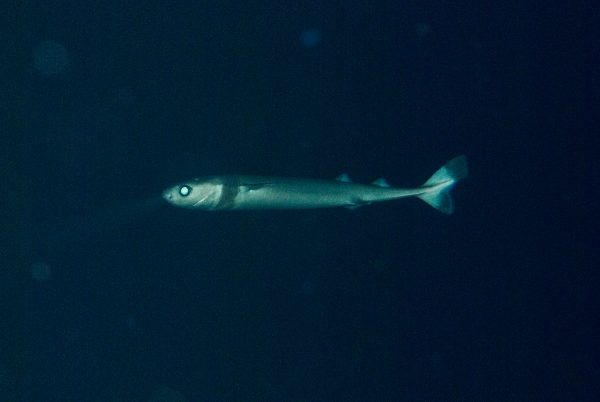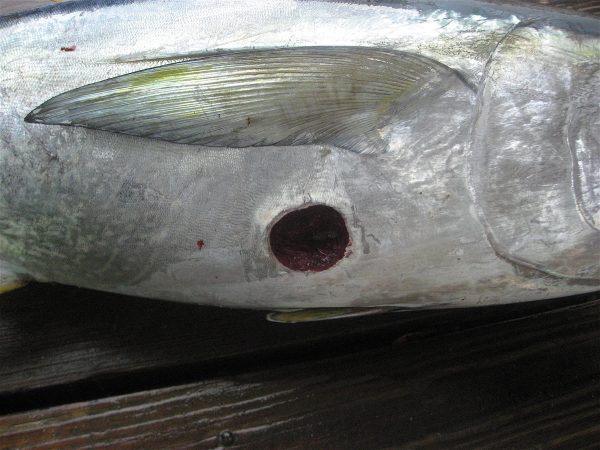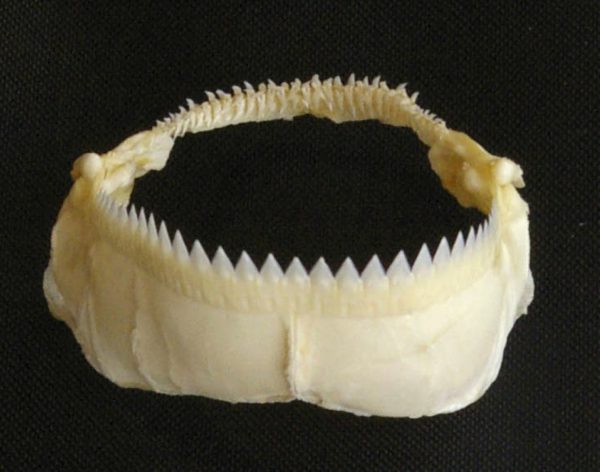Researchers have discovered the great white shark, one of the most feared ocean predators, can occasionally become prey for the mysterious cookiecutter shark, a lone predator one-tenth its size.

Photo by J. Lambus Photography
When feeding, the cookiecutter shark bites its victim and then rotates to remove a plug of flesh, often leaving large prey injured but alive. A team of scientists including a Museum researcher documents the first evidence of a cookiecutter bite on a great white shark in a study appearing online and in the January print issue of Pacific Science.
“It’s normally big sharks that get media coverage, but many people don’t realize there are species of shark that don’t get larger than 2 feet,” said co-author Yannis Papastamatiou, a marine biologist in the division of ichthyology at the Florida Museum of Natural History on the UF campus. “In most cases, these little sharks will eat little prey, but with cookiecutter sharks, you have this unique situation of a small shark that will target animals much, much larger than itself, up to 10 times their own size, and that’s pretty unique in the animal kingdom – it’s a very active foraging process.”

Photo courtesy John Soward
In the study, researchers describe a bite wound near the white shark’s mouth that was photographed by a diver in a shark cage near Guadalupe Island in the Pacific. The cookiecutter was identified as Isistius brasiliensis, the same species that attacked a swimmer in 2009.
A type of dogfish shark, cookiecutters inhabit deep tropical waters and their bites have been found on many animals, including tuna, whales, dolphins, swordfish and elephant seals.
“When biologists first started noticing the bites on the pelagic fishes and whales, they thought it might be a viral infection because they didn’t know any animal that could bite and leave such a smooth wound,” Papastamatiou said. “And it’s not only animals – they’ve taken chunks of plastic out of submarines and underwater oceanographic equipment, so it’s pretty amazing what they can do.”
Unlike other sharks, a cookiecutter’s teeth are connected at the bottom in the lower jaw, allowing them to scoop out the flesh of their victims. They have the largest teeth of any shark in relation to the size of their jaws. Cookiecutters are also bioluminescent, producing their own light on parts of their bodies, which researchers believe they may use to hide among squid that are preyed on by larger fish, such as tuna. The sharks then surprise the larger fish, taking bites before quickly leaving the scene.
“It’s a very mysterious little fish in a lot of ways and that’s mainly because it’s so difficult to study — you hardly ever see them alive,” Papastamatiou said. “We really have to study cookiecutter sharks based on either dead specimens or by their bite wounds on prey.”

Photo courtesy Hawaii Division of Aquatic Resources
The research helps scientists better understand the biology of cookiecutter sharks and shows top predators like the great white are not as free of natural predators as people may think, said John McCosker, a senior scientist at the California Academy of Sciences.
“The public thinks that white sharks, based on the film ‘Jaws,’ are the ultimate predator, whereas even white sharks are preyed upon in this case, by a shark no longer than your forearm,” McCosker said. “Rather like every other species in the world, it has its own difficult species to deal with, in this case, more like a gnat in comparison in body size and irritation, but nothing is free from parasitism, our species included. Hopefully the white shark will get the reputation it deserves, and that is as a keystone species, in that all sharks have an important role within the ecosystem – we need them more alive than we do dead.”
Papastamatiou is one of few researchers worldwide who has witnessed a cookiecutter shark in the wild, he said. He and co-author John O’Sullivan, curator of field operations and a senior collector at the Monterey Bay Aquarium in California, attempted to track a cookiecutter in the Pacific in 2010.
“We basically had given up and started to head up to the surface when I noticed this little fish behind me, looking at me,” Papastamatiou said. “When I turned around, there was a cookiecutter shark just staring at me. I tried not to startle it by moving too quickly so I could get a photograph, but he just sort of did a couple of laps around me and then spiraled down into the depths.”
The lead author of the study is Mauricio Hoyos Padilla, director of Pelagios-Kakunjá A.C., a nongovernmental organization that studies sharks and manta rays. Christopher Lowe of California State University is a study co-author.
Learn more about the cookiecutter shark (Isistius brasiliensis)
Learn more about Ichthyology at the Florida Museum.